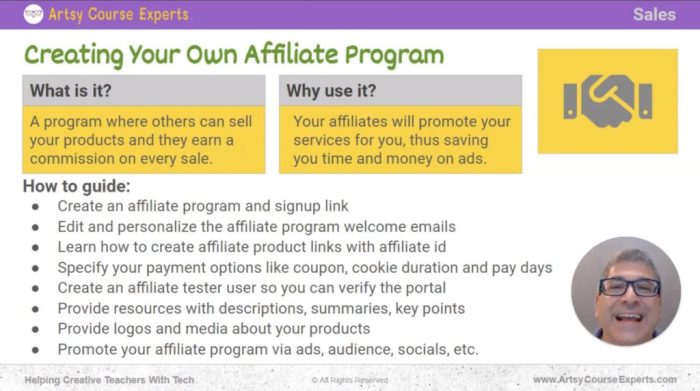Creating an Affiliate Program kicks off a lucrative journey into the world of online marketing, where partnerships and profits go hand in hand. From understanding the basics to optimizing conversions, this guide covers it all.
Get ready to delve into the realm of affiliate programs and unlock the potential for growth and success in your business.
Understanding Affiliate Programs
An affiliate program is a marketing strategy where a company pays a commission to individuals (affiliates) for promoting and driving sales to the company’s products or services through their unique affiliate link. Affiliates earn a percentage of the revenue generated from the sales they refer, incentivizing them to actively promote the company.
Examples of Successful Affiliate Programs
- Amazon Associates: Amazon’s affiliate program allows affiliates to earn a commission on sales generated through their referral links.
- Shopify Affiliate Program: Shopify offers affiliates the opportunity to earn a commission for each new customer they refer who signs up for a paid plan.
- Bluehost Affiliate Program: Bluehost provides affiliates with a commission for each sale made through their referral link for web hosting services.
Benefits of Creating an Affiliate Program
- Affiliate programs can help businesses increase sales and reach a wider audience through the promotion efforts of affiliates.
- It is a cost-effective marketing strategy as businesses only pay commissions for actual sales generated through affiliate efforts.
- Affiliate programs can boost brand awareness and credibility as affiliates promote the products or services to their own audience.
- Businesses can benefit from the expertise and reach of affiliates who can drive targeted traffic to their website and increase conversions.
Setting Objectives

Setting clear objectives for an affiliate program is crucial for its success. These objectives should be specific, measurable, achievable, relevant, and time-bound (SMART). It’s essential to align the goals of the affiliate program with the overall business objectives to ensure that efforts are in sync and driving the company forward.
Importance of Aligning Goals
When the objectives of the affiliate program are aligned with the business goals, it ensures that all efforts contribute to the growth and success of the company. This alignment helps in focusing the affiliate program towards achieving milestones that matter the most to the business, whether it’s increasing sales, expanding market reach, or improving brand awareness.
- Ensure that the affiliate program objectives are in line with the overall marketing strategy of the business.
- Define clear KPIs (Key Performance Indicators) that directly impact the business goals.
- Regularly track and measure the performance of the affiliate program against these aligned objectives.
- Communicate the importance of aligning goals to all stakeholders involved in the affiliate program.
Setting Realistic Targets
It’s important to set achievable and realistic targets for the affiliate program to maintain motivation and drive results. Unrealistic goals can lead to frustration and demotivation among affiliates. Here are some tips to set realistic targets:
- Consider the historical performance of the affiliate program to set benchmarks for future targets.
- Take into account the capabilities and capacity of the affiliate network when setting targets.
- Break down larger goals into smaller, manageable targets to track progress effectively.
- Adjust targets based on market trends, competitor analysis, and other external factors that may impact the performance of the affiliate program.
Choosing Commission Structures: Creating An Affiliate Program

When it comes to setting up an affiliate program, choosing the right commission structure is crucial for the success of your program. Different commission structures offer various benefits and drawbacks, so it’s essential to understand the differences between pay-per-sale, pay-per-click, and pay-per-lead models to make an informed decision.
Pay-Per-Sale
- Pros:
- Direct correlation between sales and commissions.
- Affiliates are motivated to drive quality traffic and conversions.
- Cons:
- Risk of fraud as affiliates may resort to unethical practices to increase sales.
- May not be suitable for products with long sales cycles.
Pay-Per-Click
- Pros:
- Low risk for the merchant as they only pay for clicks.
- Can be beneficial for affiliates with high traffic websites.
- Cons:
- Less incentive for affiliates to drive actual sales.
- Subject to click fraud which can inflate costs without generating revenue.
Pay-Per-Lead
- Pros:
- Leads are valuable for businesses and can lead to long-term relationships.
- Affiliates can earn commissions without the pressure of making a sale.
- Cons:
- Quality of leads may vary, impacting the effectiveness of the program.
- Can be challenging to track and verify leads accurately.
Recruiting Affiliates
When it comes to recruiting affiliates for your program, it’s essential to have a solid strategy in place. You want to attract affiliates who are not only motivated but also aligned with your brand and target audience. Building relationships with your affiliates is crucial for long-term success.
Effective Strategies for Recruiting Affiliates
- Utilize social media platforms to reach out to potential affiliates and showcase the benefits of joining your program.
- Attend industry events and conferences to network with potential affiliates in person.
- Create targeted email campaigns to introduce your affiliate program and its unique selling points.
Qualities to Look for in Potential Affiliates
- Relevant audience: Look for affiliates who have an audience that aligns with your target market.
- Good reputation: Choose affiliates with a positive reputation in the industry to enhance your brand image.
- Strong communication skills: Opt for affiliates who can effectively promote your products or services to their audience.
Building Relationships and Keeping Affiliates Engaged
- Provide regular updates on new products, promotions, and affiliate incentives to keep affiliates informed and engaged.
- Offer personalized support and training to help affiliates maximize their earning potential.
- Recognize and reward top-performing affiliates to show appreciation for their hard work and dedication.
Providing Marketing Resources
When it comes to running a successful affiliate program, providing marketing resources to your affiliates is key. These resources help affiliates promote your products effectively and drive more sales.
Type of Marketing Resources, Creating an Affiliate Program
Here are some essential marketing resources to offer to your affiliates:
- Banners and ads in different sizes and formats for website placement
- Product images and videos for social media promotion
- Pre-written email templates for easy outreach
- Custom tracking links for accurate commission attribution
Importance of Providing Creative Materials
By offering affiliates creative materials, you make it easier for them to promote your products. These resources help maintain brand consistency and ensure that affiliates convey the right message to their audience.
Empowering affiliates with creative materials can lead to higher conversion rates and increased earnings for both affiliates and merchants.
Examples of Successful Marketing Resources
Some affiliate programs have excelled in providing top-notch marketing resources:
- Amazon Associates offers a wide range of product images, banners, and widgets for affiliates to use on their websites.
- Shopify Affiliate Program provides affiliates with marketing guides, case studies, and email templates to assist them in promoting Shopify’s platform.
- Adobe Affiliate Program gives affiliates access to demo videos, tutorials, and promotional assets to showcase Adobe’s software products effectively.
Tracking and Monitoring Performance
Tracking and monitoring affiliate performance is crucial for the success of an affiliate program. It allows you to assess the effectiveness of your affiliates, identify areas for improvement, and make informed decisions to optimize your program.
Key Performance Indicators (KPIs)
- Affiliate Sales: Measure the number of sales generated by each affiliate to gauge their performance.
- Conversion Rate: Track the percentage of clicks that result in a successful sale to evaluate affiliate effectiveness.
- Click-Through Rate (CTR): Monitor the percentage of clicks on affiliate links compared to the total number of impressions.
- Revenue per Click (RPC): Calculate the average revenue generated per click to assess affiliate profitability.
Tools and Software for Tracking Affiliate Performance
- Affiliate Tracking Software: Utilize platforms like Post Affiliate Pro, Refersion, or ShareASale to track affiliate sales, clicks, and commissions.
- Google Analytics: Track affiliate traffic, conversions, and user behavior to gain insights into affiliate performance.
- Performance Dashboards: Use tools like Tapfiliate or Affise to create customized dashboards for monitoring KPIs and affiliate performance metrics.
Optimizing Conversion Rates
When it comes to optimizing conversion rates in an affiliate program, there are several strategies that can be implemented to increase the chances of turning leads into customers. One key aspect to focus on is the role of landing pages and promotional offers in improving conversions. By creating compelling landing pages and enticing promotional offers, affiliates can attract more potential customers and increase the likelihood of conversion.
Successful conversion rate optimization techniques are crucial for the success of an affiliate program.
Utilizing Engaging Landing Pages
Creating visually appealing and user-friendly landing pages is essential for optimizing conversion rates. A well-designed landing page that clearly conveys the value proposition of the product or service being promoted can significantly impact conversion rates. Including compelling call-to-action buttons, relevant images, and concise copy can help guide visitors towards making a purchase.
- Utilize A/B testing to determine which elements of the landing page are most effective in driving conversions.
- Ensure that the landing page is mobile-responsive to cater to users accessing the site from various devices.
- Include customer testimonials or reviews to build trust and credibility with potential customers.
Offering Irresistible Promotional Deals
Promotional offers play a vital role in enticing potential customers to take action and make a purchase. By providing exclusive discounts, limited-time promotions, or free trials, affiliates can create a sense of urgency and incentivize conversions. Offering valuable incentives can help overcome any hesitations or objections that potential customers may have.
- Collaborate with merchants to create special promotional codes or offers exclusively for affiliate marketing campaigns.
- Create a sense of scarcity by highlighting limited-time promotions or exclusive deals to encourage immediate action.
- Personalize promotional offers based on the preferences and behavior of the target audience to increase relevance and effectiveness.
Implementing Dynamic Content Optimization
Dynamic content optimization allows affiliates to personalize the user experience based on individual preferences, behavior, and demographics. By leveraging data analytics and automation tools, affiliates can deliver targeted content to specific audience segments, increasing the likelihood of conversion. Personalized recommendations, tailored messaging, and relevant content can enhance the overall user experience and drive conversions.
- Segment the audience based on key characteristics such as location, interests, or purchase history to deliver personalized content.
- Use retargeting strategies to re-engage users who have previously shown interest in a product or service but did not complete a purchase.
- Optimize the content based on real-time data and insights to continuously improve conversion rates and maximize ROI.
